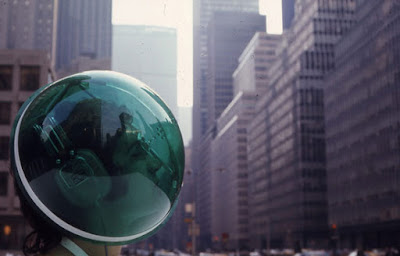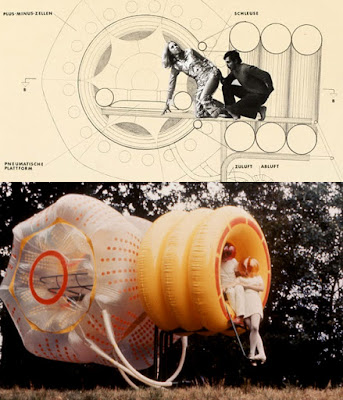Realms of the idealist. Haus-Rucker-Co (part 2)
Images: from top, Environmental Transformer (1968), Pneumakosm (1967), Mind Expander (1968), Yellow Heart (1967), Mind Expander (1968), Globo para 2 (1967)
So called radical architecture may have fallen out of favor, replaced by the more formulated styles of structural design. Yet, in this series Relams of the Idealist, what was born from the 1960s and the manifestation of these architectural idealists as afar as an attempt at imprinting and questioning discourse against traditional forms of design, have received an equal amount of both praise and criticism over the years. The critique was one of the disposable, that the Italian conceptual architect designers such as Archizoom and their contemporaries, at the time, Super Studio envisioned. A modular world made up of plastic shapes. Such a disposable concept of structural design, to which four decades later there is now a rejection of plastics, due to its environmental impact, particularly on the oceans and sea life. But, these criticisms of an era such as the 1960s where the modularity of design encouraged by the newer plastic industries, does not herald true as a criticism, more so it was the innovation that the radical designers achieved in their time of challenging the rigidity of development and consumption, a desire to implement their Utopian template, which was also projected by 1960s and 70's pop-culture aesthetics.
The Haus-Rucker-Co idealism of design centered around participant's experience of their urban environments, the Austrian design team called these interactions, within their plastic encased orbs, “Mind-expanders”, which when observed in the context of the 60's space age and the political and social turmoil of the era makes sense. Before digital technology and hyper connectivity that we know of today, the pace of technology was unprecedented at the expense of crumbling infrastructure and cities that diverged whilst falling into disarray. Haus-Rucker-Co chose to explore the cosmos which was an internal journey, on Earth, projected by the concept, through technology, that one could find detachment – particularly when adorning their “Fly helmets” via the group's “Environmental Transformer Projects”.
This environmental detachment, in my opinion, holds more of insulation from the exponential urbanism of 1950s expansion and consumption which came to a dramatic end in the 60's and 70's as the atrophy and the dawn of the computer age merged. Yet, there is still a relevancy to the concepts of Haus-Rucker-Co that after all these years when the Austrian designers began to retrofit their inflatable creations onto urban fixtures, we may, now in the 21st Century seemly think that we have smoothed out urban decay and its discord, yet this is all but an illusion of grandeur under the digital banner of advancement and cheap money - it is the prefabrication of of the urban construct that is only hiding the decay and with a pandemic issuing its reign of social confusion throughout society, the dilapidation has become more revealed. Viewing the cities in one of Haus-Rucker-Co's Mind Expanders could very well offer, in its aesthetic symbolism, a unique alternative.








Comments
Post a Comment